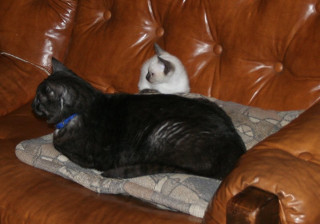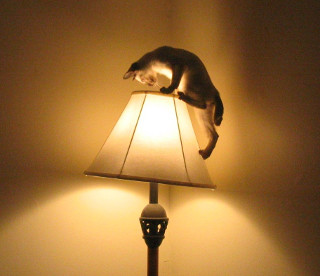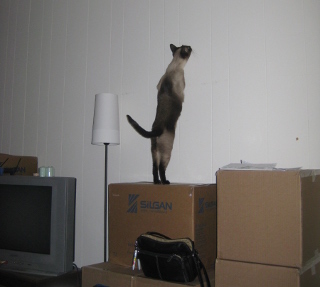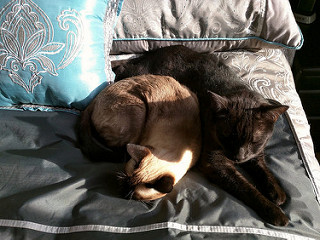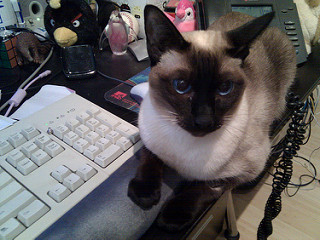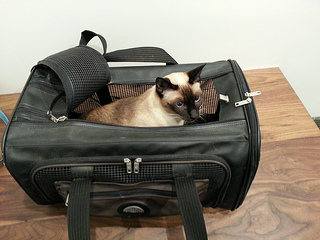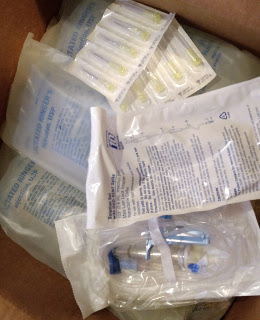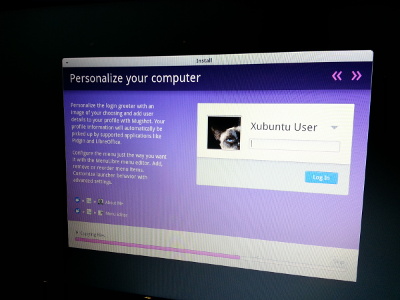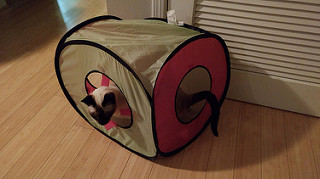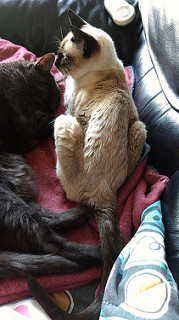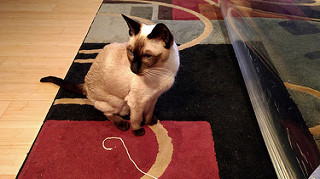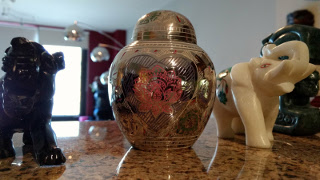Rounding out over ten years of a wonderful life, and over five years of treatment for Chronic Renal Failure (CRF), Simcoe passed away on April 9th.
I picked up tiny baby Simcoe on a snowy night in January of 2007. The litter of kittens she came from had two girls, and I picked the one I saw first. Her whiskers were a bit mangled due to some rough play with a sibling but she was the one who was least skittish in the crew if naturally skittish Siamese. And she was so small! Her introduction to Caligula was tense at first but within just a couple days he grew accustomed to her.
Simcoe was named after a hop. I was really into local breweries and homebrew in the mid 2000s, even having grown nugget hops in our back yard in Pennsylvania. The hop was distinctive and I enjoyed it, and the name was great. Though it did cause a lot of people to mix up her gender over the years since the name was not obviously gendered.
As a kitten, she was a bit of a terror. Climbing so many places where she shouldn’t be, taking her claws to a pair of speakers and some furniture. She also loved attacking toilet paper, which I eventually trained her out of. She never quite settled down like Caligula did into full adult cat mode, but she did calm out of her kitten phase eventually after she learned some rules and would at least abide by them while we were watching. She also stopped the furious little kitten destruction-of-things and as an adult was quite kind and careful.
Simcoe was with me through a divorce and total up-ending of my life as I left the Philadelphia area where I spent much of my 20s and moved to San Francisco. When I moved to San Francisco in 2010 there were months of unpacking as I struggled to juggle work and my new life out west. During this time she developed a habit of hopping on top of one of the larger boxes when MJ came home so he could pet her. I was thrilled with how quickly they bonded. She also took to city life quickly, and the beautiful weather we often enjoy here in northern California.
She was a bouncy kitty whose boundless affection touched everyone who spent much time with her. She was playful and funny, making for endless photos of her escapades I could share. There were mornings when I’d wake up with cat toys in the bed, a clear indication that it was time to play with her whenever I decided to get myself out of bed. She also spent a lot of time snuggling Caligula, following him around to figure out where he was sleeping so she could join him, and had a funny habit of trying to nurse from him. I tried to capture much of this this post, which I wrote the day after she passed away.
On November 22nd of 2011 our Simcoe turned five years old. She’d always been a small cat, but in the weeks following her birthday we realized she had lost a considerable amount of weight. We brought her in to the vet on December 10th and learned that she had dropped from about ten pounds to just over six. I wrote about that first week of learning she was sick here, but suffice to say we learned that she had CRF, an incurable condition that we could treat, but was ultimately fatal. It was devastating. I cried a lot during the 72 hours they worked to get her stable at the vet through constant fluids and a watchful eye.
After a few days, she came home to us. The next several weeks were spent learning how to care for her. Thankfully MJ had experience giving cats subcutaneous (SubQ) fluids, as it seemed so daunting when the vet explained that we had to put a needle under the skin of her neck to administer fluids. We even brought her up to a veterinary hospital over an hour north of San Francisco to visit a feline kidney transplant doctor. We also completed various preliminary tests to see if she was a good candidate for transplant. Ultimately after discussion with all the vets involved, we all decided to hold off on the transplant because we wanted to try management of her condition once her values evened out at the end of December, showing that she was in the early stages of the disease.
While doing all these tests related to the disease and transplant eligibility, we also learned that she had an infected tooth that was causing trouble. In mid-January we took the calculated risk of having her put under to get the tooth taken care of. The infection was considerably worse than they thought, so the procedure took longer and there was a dip in blood pressure they had to control, but over all she was ok. By February we were getting into the swing of things care-wise. In April we had to make our first trip where we’d leave our newly diagnosed kitty in the care of a pet sitter who came to the house daily, but we found one and it worked out fine. We continued to use the same pet sitter over the next five years. Her weight bounced back, gaining steadily throughout 2012 and bringing her back up to a healthy 9.5 by the end of the year where she remained while she was doing well.
Plus, she was an awesome cat! And we spent a lot of time together since I work from home.
Check-ups every three months over the next few years became the norm. I wrote about them each time, finding the tracking and writing to be therapeutic and always hoped that sharing our journey would be helpful to others. The full listing, for reading in detail about her progression:
- May 3, 2012: Simcoe’s April Checkup
- August 9, 2012: Simcoe’s August Checkup
- November 30, 2012: Simcoe’s November Checkup
- March 8, 2013: Simcoe’s March Checkup
- June 12, 2013: Simcoe’s May Checkup
- December 10, 2013: Simcoe’s November Checkup
- February 2, 2014: Simcoe’s January vet visit and Caligula’s cold
- June 9, 2014: Simcoe’s June Checkup
- August 26, 2014: Simcoe’s August 2014 Checkup
- December 6, 2014: Simcoe’s December 2014 Checkup
- March 14, 2015: Simcoe’s March 2015 Checkup
- July 2, 2015: Simcoe’s July 2015 Checkup and Beyond
- September 17, 2015: Simcoe’s September 2015 Checkup
- November 21, 2015: Simcoe’s November 2015 Hospital Checkup
- January 15, 2016: Simcoe’s January 2016 Checkups
- March 29 & June 29, 2016: Simcoe’s March and June Checkups
- October 13, 2016: Simcoe’s October Checkup
- January 7 & March 11, 2017: Simcoe’s January and March 2017 Checkups
We decided in the course of this to discontinue our plans for a renal transplant. The vet up north had retired and his practice ceased doing the procedure. We also learned that there hadn’t been any major improvements in the procedure in the years that had elapsed since her diagnosis, it was still expensive and risky, with a high level of care required after the transplant, which I thought we might struggle with.
She was responding incredibly well to treatment, in addition to a healthy weight, her BUN and Creatinine levels stayed reasonable for her condition. We adjusted some additional supplements, changed up her food from time to time as it made sense to tend to her treatment. Her and Caligula did end up swapping colds over the years, but after seeing the vet a few times for it they said it was just the way some pairs of cats are with these things, and aside from sniffles and sneezing, it didn’t seem to make much of an impact on their general well-being.
In 2014 she became immortalized in a software project I work on. With the Xubuntu 14.04 release the login greeter garnered the ability to have a personalized picture next to your login name. The team flipped through some options for the default picture in the installer, and decided upon the striking image of beautiful Simcoe.
This wasn’t the full extent of her internet fame though. I shared pictures of her all the time on social media, so everyone who knew me, knew my cat. It did make me a bit of a cat lady, but that’s totally fair, it’s tricky to pull my identity away from my beloved critters.
Alas, CRF is a disease that progresses, and late 2015 is when things started shifting. First her weight began to drop. Then she started breaking out with sores around her eyes and nose, which were first treated, probably unsuccessfully, with antibiotics. Then, after a large sore on the base of the underside of her tail developed along with the other sores we took her to a dermatologist. We learned that she had allergies which were causing the breakouts. The doctor didn’t believe it was related to the CRF directly, but did say that her weakened immune system could be making it so that the sores resulting from the breakouts failed to heal quickly, risking infection. A small dose of daily anti-allergy medication cleared it up nicely and there were no further incidents. Her health was declining though.
Through 2016 her BUN and Creatinine levels continued to rise and her weight drop. Her damaged kidneys were incredibly small and it surprised the vet that they were functioning at all. We increased her SubQ fluids to 100 ml daily. She was put on a couple more medications to manage her calcium levels and other things that had started getting out of whack with the progression of the disease. In general, she was still acting fine though, in spite of the stage four renal failure diagnosis she ended up with last year. Everyone was surprised at how well she was handling it.
She did develop severe constipation though, which caused her visible distress and made it so she’d sometimes find a more comfortable place than her litter box to do her number two business, often our bed. In addition to covering the bed more aggressively, this led us to various attempts to give her more fiber, with varying success throughout the year. Mixing fiber-for-humans in with wet food, giving her some mixed with water directly. At the end of the year we decided the positives outweighed the negatives and switched her to a daily medication which helped ease the constipation, but while safe, wasn’t quite optimal for a CRF cat, though it did start to relieve the constipation.
By the end of 2016 her weight had dropped below eight pounds and our concern was growing. She then rapidly dropped below seven pounds over the first couple months of 2017, and in March her energy took an unexpected dip. She wasn’t as playful, slept more, and when she was awake she would often rest in a somewhat hunched position. Her meowing got more frequent, especially at night, and came to my lap to snuggle much more frequently than normal. Her appetite had decreased a lot as well.
With her steady decline we looked into transplants again, somewhat out of desperation and desire not to lose her. I went as far as having a call with UPenn’s feline renal transplant department and talking to our local vet about preparatory and follow up care here. But she was really not doing well, the trip across the country for the transplant, in spite of having a place there where she could begin recovery, would have been challenging. Life post-surgery would have also been difficult for all of us, two anti-rejection medications per day, need to stay away from infections since her immune system would be compromised. We made the heartbreaking decision not to move forward with the transplant.
The week of April 3rd showed further behavior changes. Her breathing was sometimes labored and scratchy as it seems like she was going through another bout of respiratory issues. She was climbing to unusual places, and being excessively heat-seeking. I’d find her on top of the toaster oven, sitting on our computer equipment. She had also almost completely stopped eating. We could get her to eat a little cold cut turkey (her favorite!) but even that she lost interest in quickly, and vomited much of it up.
On April 7th Simcoe had a urine accident in our bed, which had never happened before. She was clearly distressed by the situation and paired with her general lethargy and change in behavior over the preceding weeks made us decide it was time to let her go. We made an appointment with an in-house vet Sunday morning. Early Saturday morning I found her on top of our computer rack in my office, when I picked her up she was soaked with urine, seemingly had an accident again and yet didn’t move from where she was. She barely fought me when I cleaned her up in the bathtub.
We spent the rest of the day with her. Playing with her favorite toys (string! seagull!) and cat tents, she even took a few bites of cold cut turkey. Saturday night MJ and I took shifts to stay up all night with her. He stayed up until the early morning, waking me up around 5AM so I could spend some final hours with her. She spent much of those final hours sleeping on me, or near me on a heated blanket with Caligula. In the late morning before the vet showed up she perked up and played a bit. I immediately thought we were making a mistake in having her put to sleep, but all the other evidence of her decline outweighed that final playtime.
The vet arrived on time and walked us through the procedure. He was super compassionate and friendly, and remarked at how beautiful she looked. Indeed, many cats are unable to groom themselves effectively when they get to where she was, but she’d always been a super groomer, so she was beautiful even at the end. MJ held her as we sat together on the couch as he administered the shots and we felt her slip away there as we petted her. We brought Caligula over so he could say goodbye, though he didn’t seem to understand. The vet took her away in a little basket and she just looked like she was sleeping. He took care of the cremation details and explained that her ashes would be returned to us in a couple weeks.
It’s now been almost four weeks since her passing, and this is still incredibly painful to write. Losing her has been one of those really hard losses. We have her ashes back now, in a beautiful lotus urn. We haven’t yet had the discussion of where to spread them, but I’ve kept it in my thoughts should inspiration arise.
These past few weeks I’ve realized how much we’d adjusted our lives to handle her care. She had a history of vomiting, so we’d been diligent about covering the bed with a waterproof cover as soon as we got up in the morning, and were careful not to leave out papers she could potentially get sick on. Laptops had to remain closed so she wouldn’t sit on the keyboards. There was also the daily care. Every night we made time to give her medication and SubQ fluids. And all the vet visits, at least quarterly. The pet sitter who had to be familiar with administration of SubQ and medications.
But we’d do it all again without a second thought. It was worth it to have her part of our lives for so many wonderful years. It seems like a daunting amount of work, but it really just becomes routine and not too scary.
I learned soon after her diagnosis that many vets don’t work with owners to recommend treatment and instead recommend euthanasia upon diagnosis. I would never judge those vets or owners who choose that path, it is some work and expense, but I want people to know there’s another way. Simcoe was diagnosed when she was just five years old, and she had another good five years in her beyond her diagnosis. There are great websites, communities and vets who can help CRF cats who are otherwise in good health, especially if they’re on the younger side.
Throughout the disease we kept personal records of her weight and important levels, graphing and sharing them with each blog post:
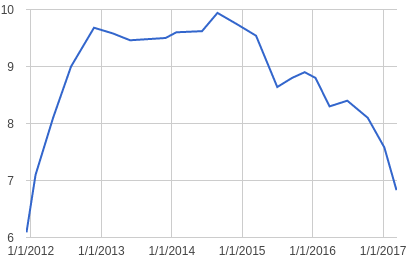
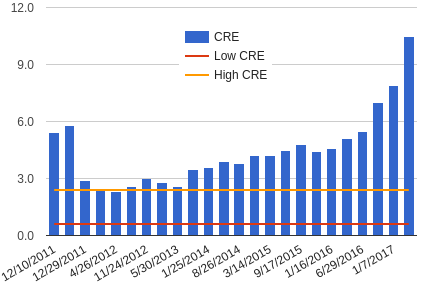
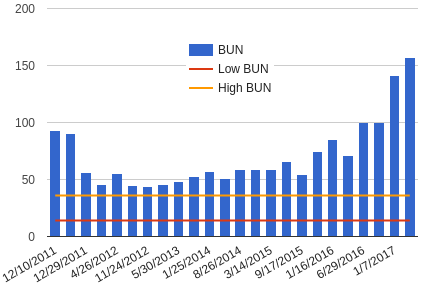
I’ve put a copy of the spreadsheet with exact levels up here, the BUN and CRE tabs include what the normal values are from the lab (these vary between labs).
We’re super thankful for the staff of both All Pets Hospital, particularly Dr. Barr and Dr. Gillespie who showed so much love and care for her early in her condition. Then as her condition worsened the welcoming staff at VCA San Francisco Veterinary Specialists and Dr. Maretzki who walked us through the end stages with us, changing up her medication regularly and helping us determine the next steps throughout. Our pet-sitter Elaine was also wonderful through all our travel as she went to great lengths to make sure Simcoe got all her medications, and who was also able to take away and donate foods that Simcoe wouldn’t eat throughout her pickier phases.
And much gratitude to friends who understand how painful this has been for me.
The following are some resources we consulted and used throughout her condition:
Tanya’s Comprehensive Guide to Feline Chronic Renal Failure Disease
This website is a treasure trove of information that we consulted on a regular basis throughout her CRF life. They talk about treatment for various symptoms that can crop up, preferred medications for CRF cats, shared stories and gave a lot of information about what you could expect in various situations. The site also included a whole chart of over the counter foods that contained tolerable nutrient balance for a CRF cat in case your cat won’t accept the prescribed renal-specific diet or you were seeking to supplement it. I would often print out sections of these charts to bring to the pet store, but the site author just published a hard copy of the US foods, which I would have bought if it had been available when I was using it. Food-wise we got lucky that Simcoe mostly ate the K/D prescription diet from Hills, but for a while we were adding in some OTC wet food to further increase the amount of liquids she was getting.
Feline Chronic Renal Failure Information Center
This is the first CRF website I found, and while Tanya’s is far more comprehensive, this one was a little less overwhelming as I started out learning about things.
Mailing lists/Yahoo! groups: Chronic Renal Failure Cats and Feline Assisted Feeding
I used these for reference and posted a few times, always receiving kind and thoughtful replies. However I could never could keep up with the volume of emails. Part of that was it was so sad to read about the struggles people were posting about, and I feared where eventually inevitable for us, and the crushing pain when people would post about the death of their cat. So I mostly let the emails pile up and used these when I needed to.
Finally, more photos of Simcoe can be found in this album and her website remains up at simcoec.at.
We love you and miss you, Simcoe. Caligula sends his snuggly love too.


